Overview
The sourcing funnel for sales success encompasses seven pivotal stages:
- Awareness
- Interest
- Evaluation
- Negotiation
- Sale
- Renewal
- Measurement
Each stage is essential for effectively guiding prospects toward conversion. Leveraging AI tools enhances these stages by improving prospect identification, engagement, assessment, and relationship management. This strategic application ultimately drives higher conversion rates and fosters long-term customer loyalty.
Introduction
In the fast-paced world of sales, grasping the sourcing funnel is essential for businesses striving to convert leads into loyal customers. This structured approach not only streamlines the identification and engagement of potential prospects but also harnesses advanced technologies like AI to boost efficiency and effectiveness.
As organizations navigate the critical stages of the sourcing funnel, they encounter the challenge of sustaining meaningful engagement while aligning their strategies with shifting market demands.
What are the pivotal stages that can drive sales success?
How can businesses optimize their sourcing strategies to maintain a competitive edge?
Websets: AI-Powered Lead Generation for Sourcing Success
Websets harnesses advanced AI algorithms to revolutionize , empowering businesses to swiftly identify and engage with potential opportunities. Its powerful search engine allows users to navigate extensive datasets, enriching results with essential information such as LinkedIn profiles, email addresses, and work histories. This functionality is crucial for sales teams and recruiters, significantly enhancing operational efficiency and strategic decision-making throughout the sourcing funnel.
Recent advancements in AI, such as predictive analytics and natural language processing, are reshaping client acquisition processes. These technologies not only automate routine tasks but also yield deeper insights into buyer behavior, facilitating more targeted outreach. Experts assert that companies leveraging AI tools can expect notable improvements in conversion rates and client qualification times. For instance, organizations employing AI-driven data enhancement have reported up to a 10% increase in conversion rates and a 30% reduction in sales timelines.
Success stories abound, with organizations that have integrated AI into their prospect generation strategies witnessing extraordinary results. By utilizing innovative platforms, companies can enhance their sourcing funnel, ensuring they connect with the right prospects at the right moment, ultimately driving sales success in an increasingly competitive landscape.
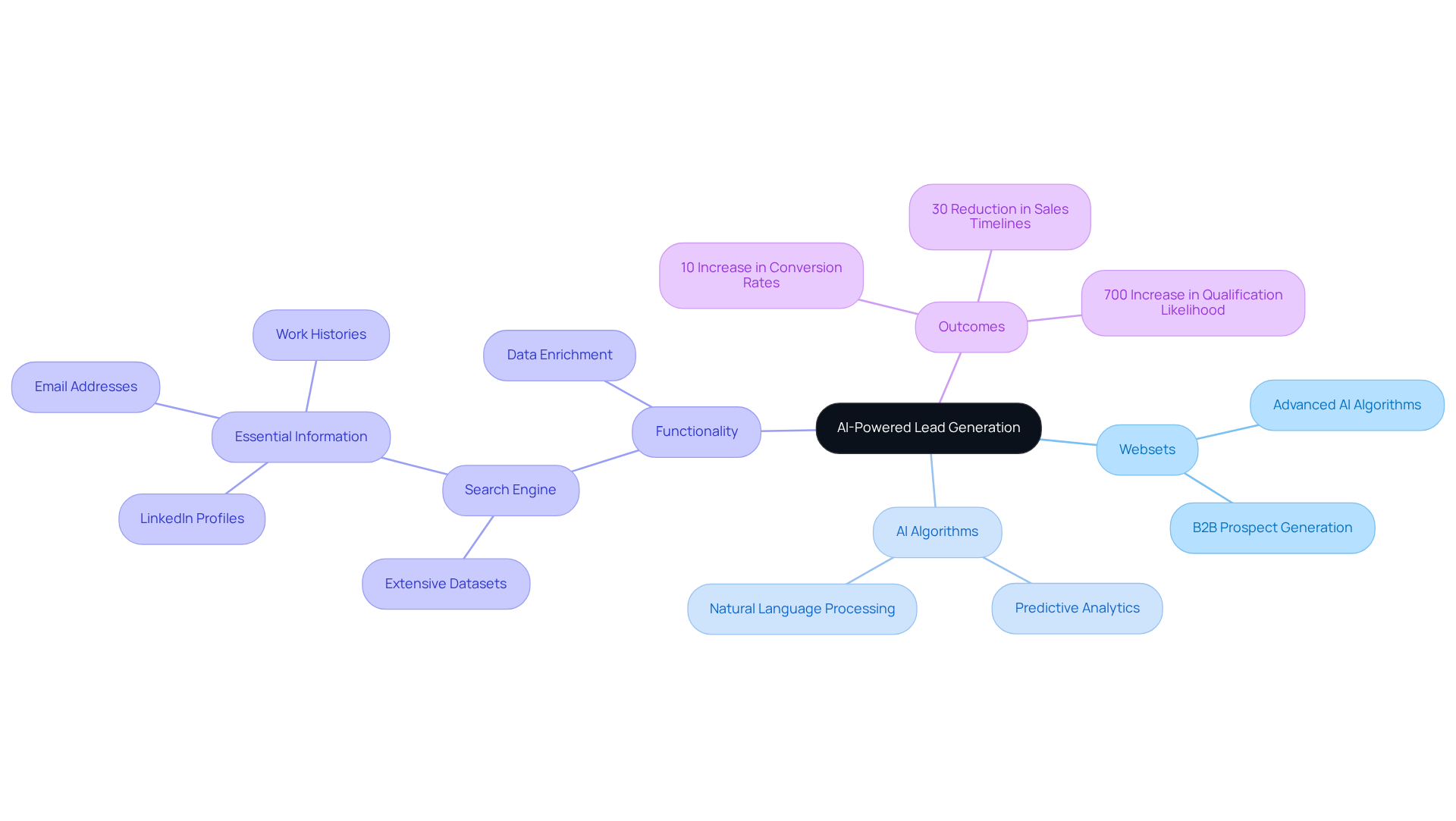
Awareness: Identifying Potential Leads in the Sourcing Funnel
In the awareness stage, businesses must cast a wide net to attract potential prospects. By leveraging AI-driven capabilities on various platforms, companies can identify prospects based on specific criteria such as industry, job title, and location. This not only ensures that the prospects entering the sourcing funnel are relevant but also enhances the likelihood of conversion. The platform empowers sales teams with accurate prospect generation at scale, enabling them to enrich their lists with valuable information, including email addresses and company details.
Moreover, efficient promotional approaches—like content marketing and social media outreach—can significantly amplify visibility and attract potential clients. By maximizing Websets' advanced search features, businesses can effectively enhance their outreach efforts. Are you ready to transform your prospecting strategy and drive meaningful engagement?
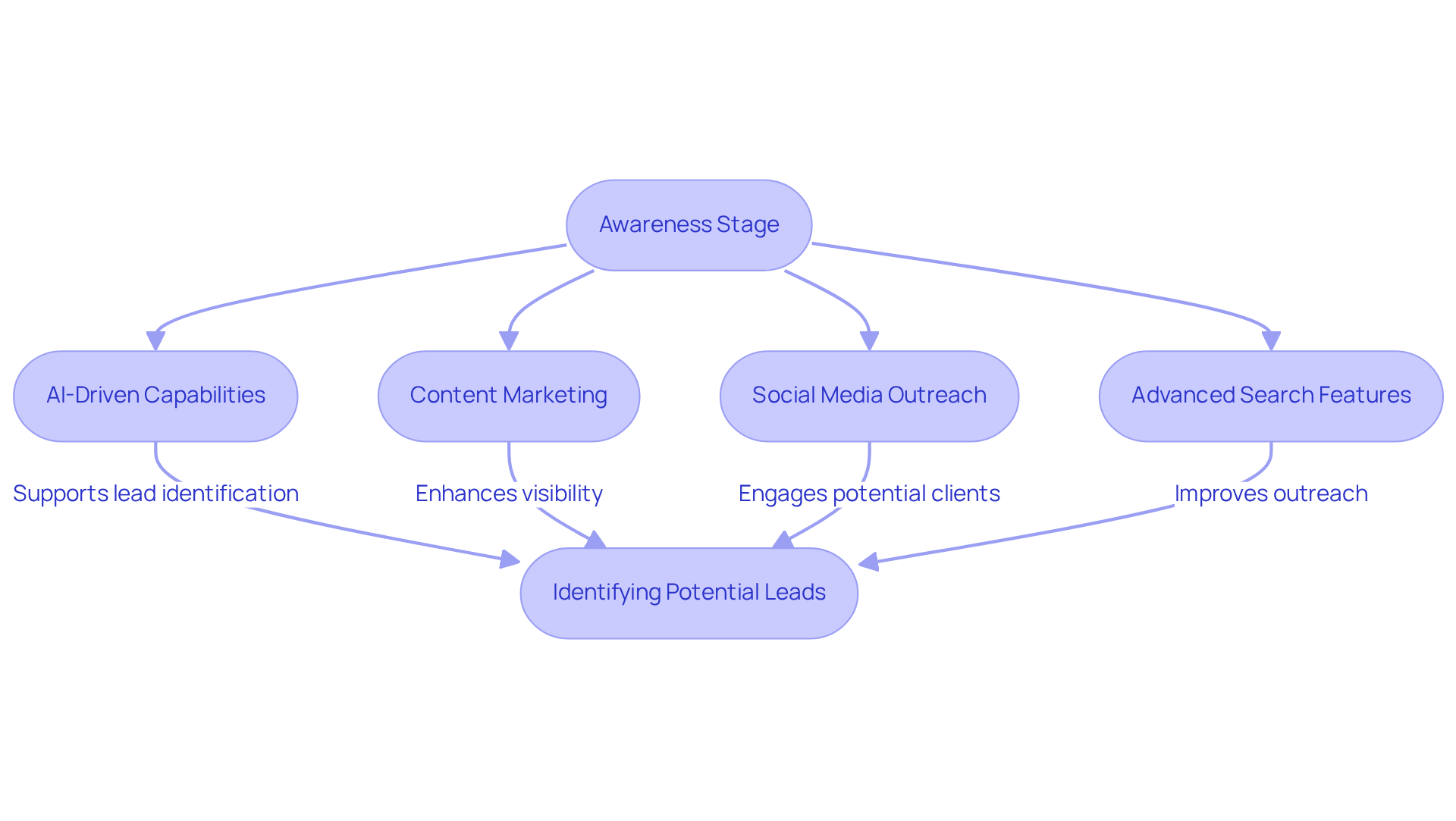
Interest: Engaging Leads to Move Them Forward
Once potential prospects become aware of your offerings, the next critical step is to engage them effectively. This engagement can be achieved through:
- Personalized email campaigns
- Informative webinars
- Targeted content that directly addresses their specific pain points
Personalized communication is vital; in fact, 80% of consumers are more likely to to individual preferences. Moreover, 71% of B2B marketers regard email engagement as a key performance metric, underscoring the necessity of tracking these metrics to refine strategies.
By leveraging advanced AI-driven tools for B2B prospect generation and people search solutions, teams can monitor these metrics and gain insights into prospect behavior, ensuring their efforts resonate with their audience. Additionally, Websets provides resources such as live demos, showcasing the platform's capabilities in real-time, along with user manuals that offer step-by-step guidance on effectively utilizing these tools.
Establishing robust connections at this stage is crucial; it not only sustains interest but also motivates prospects to progress further in the sourcing funnel. Nurturing emotional bonds can significantly influence buyers' decisions, making relationship-building an essential component of effective marketing strategies.
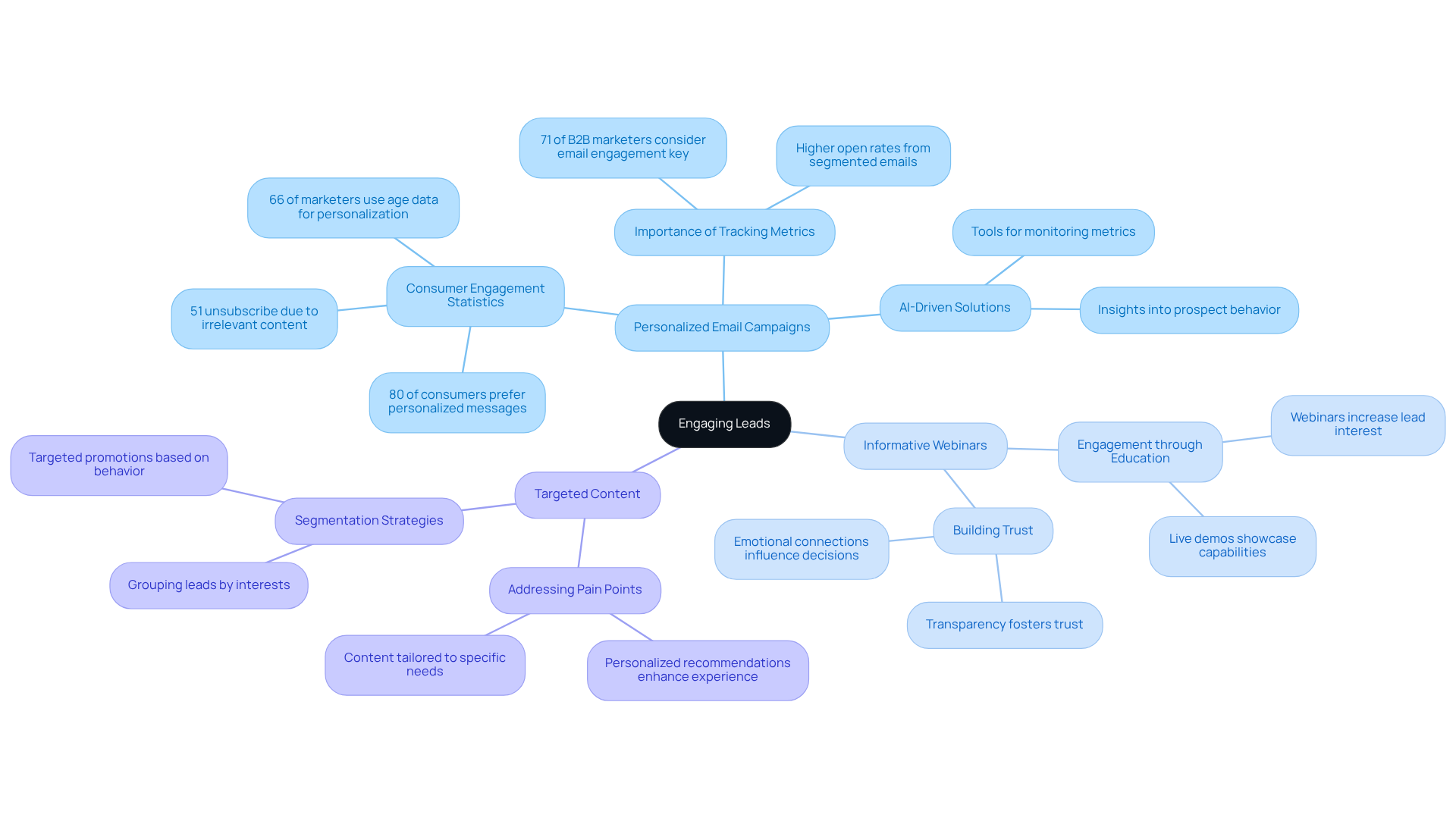
Evaluation: Assessing Lead Fit and Needs
In the evaluation phase of the sourcing funnel, it is crucial to determine whether prospects align with your ideal customer profile. This requires a thorough analysis of their needs, budget, and decision-making processes. The platform delivers vital insights and information that empower sales teams to effectively assess prospect suitability in the sourcing funnel, allowing them to concentrate on high-quality leads.
With its advanced , sales teams can leverage unique features for complex queries, ensuring access to the most relevant information. Additionally, establishing scoring systems for prospects streamlines this process, ensuring that marketing efforts are directed toward the most promising opportunities.
Furthermore, the platform offers flexible high-capacity rate limits and premium support, positioning it as an optimal solution for enterprise prospect generation and recruitment.
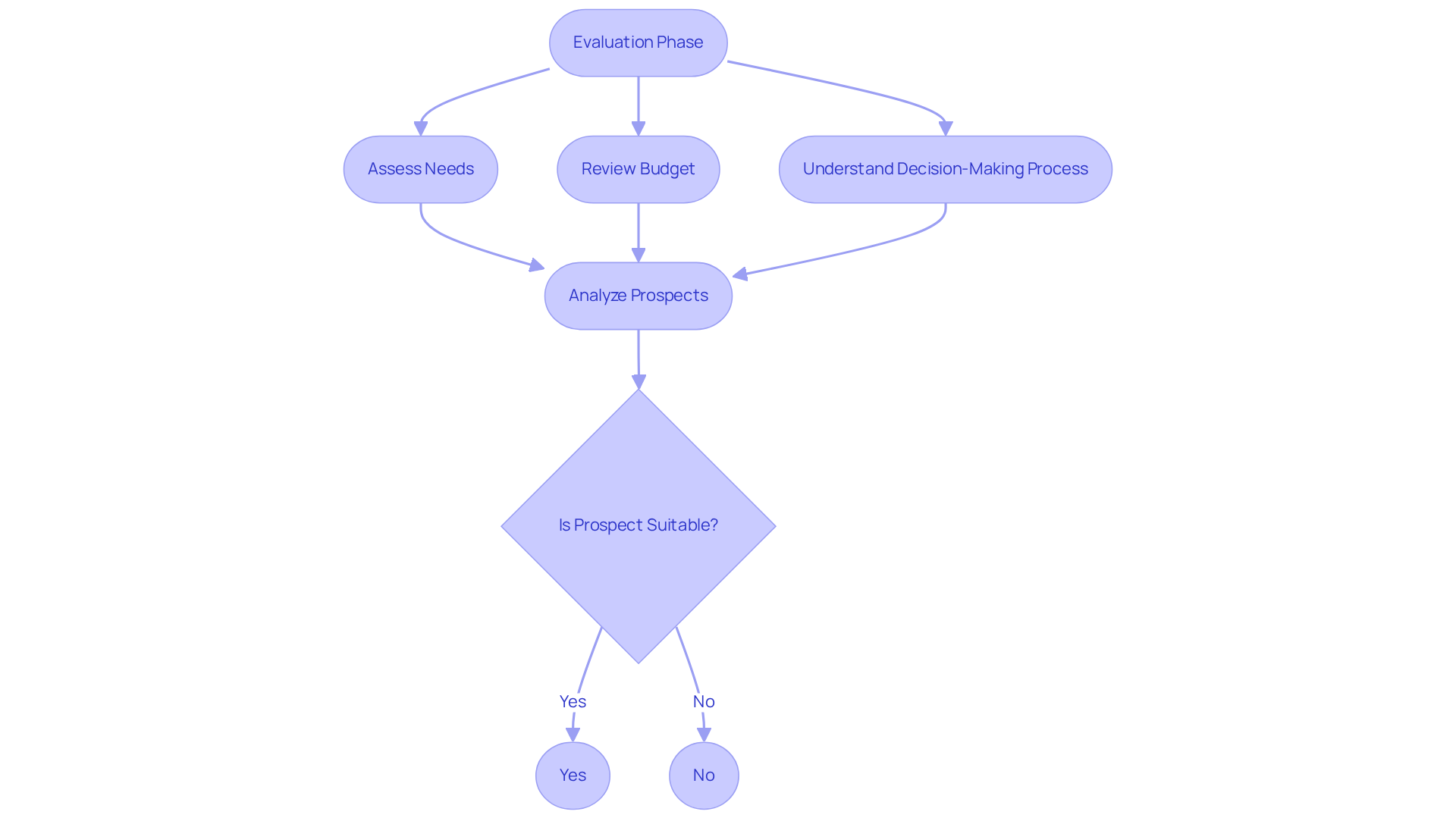
Negotiation: Finalizing Agreements with Leads
Negotiation represents a crucial phase in the sourcing funnel, as teams must effectively communicate value and address any concerns from prospects. Active listening and empathy are indispensable techniques for cultivating rapport and trust—elements that are essential for successful negotiations. Notably, 84% of business buyers prefer to engage with companies that grasp their goals, highlighting the significance of personalized communication. enhances this phase by delivering detailed insights into lead preferences and past interactions, empowering teams to tailor their proposals effectively.
Furthermore, transparent communication and flexibility during negotiations can significantly increase the likelihood of finalizing agreements. This is evident, as 66% of professionals in the field assert that effective communication strategies are vital for successful interactions. By leveraging data insights, marketing teams can navigate negotiations more strategically, ultimately leading to more favorable outcomes. The imperative for teams is clear: prioritize understanding and adapting to client needs to foster successful negotiations.
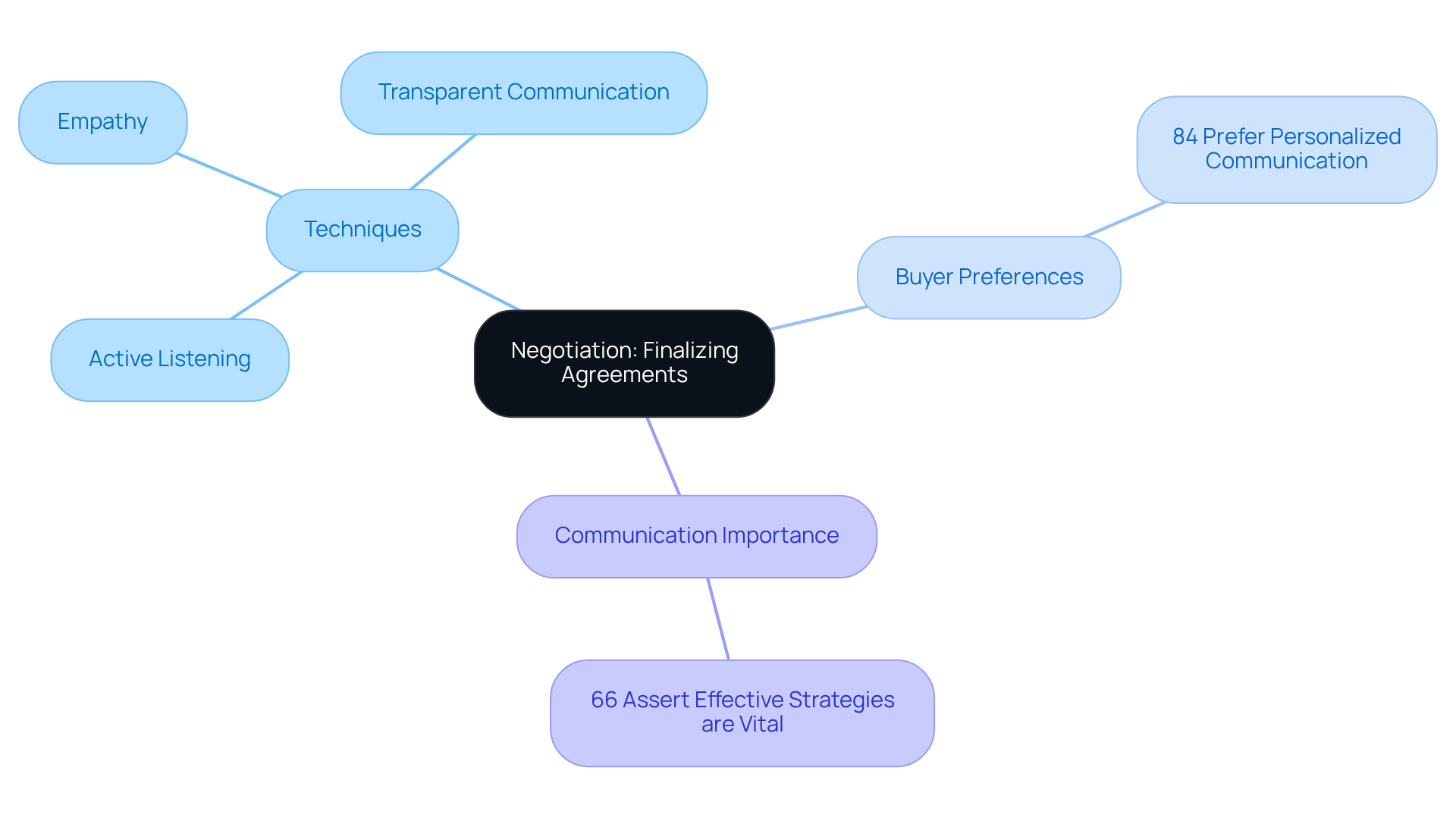
Sale: Closing the Deal in the Sourcing Funnel
Closing the deal requires a strategic approach that not only reinforces the value proposition but also effectively addresses any last-minute objections. Sales teams can employ various closing methods, such as:
- The assumptive close, which presumes the transaction is completed.
- The summary close, which recaps the advantages discussed throughout the sales process.
By leveraging Websets' AI-driven tools—like the News Monitor and Hallucination Detector—teams gain access to real-time data on lead behavior, enabling them to identify the optimal timing and method for closing, thereby significantly enhancing their effectiveness.
Notably, outreach on Tuesdays, particularly from 9-10 AM, has shown a 45% greater success rate, while mornings are 27% more effective for business calls. A successful conclusion not only secures the transaction but also lays the groundwork for future relationship building, fostering trust and encouraging repeat patronage. Organizations that adopt data-informed strategies, prioritize customer experience, and acknowledge that 80% of transactions require five or more follow-ups are more likely to achieve higher closing rates and long-term success.
As Shuai Guan, Co-founder/CEO, articulates, "Tuesday mornings, especially between 9-10 AM, are the most effective times for closing deals." This insight underscores the , compelling teams to refine their outreach strategies for maximum impact.
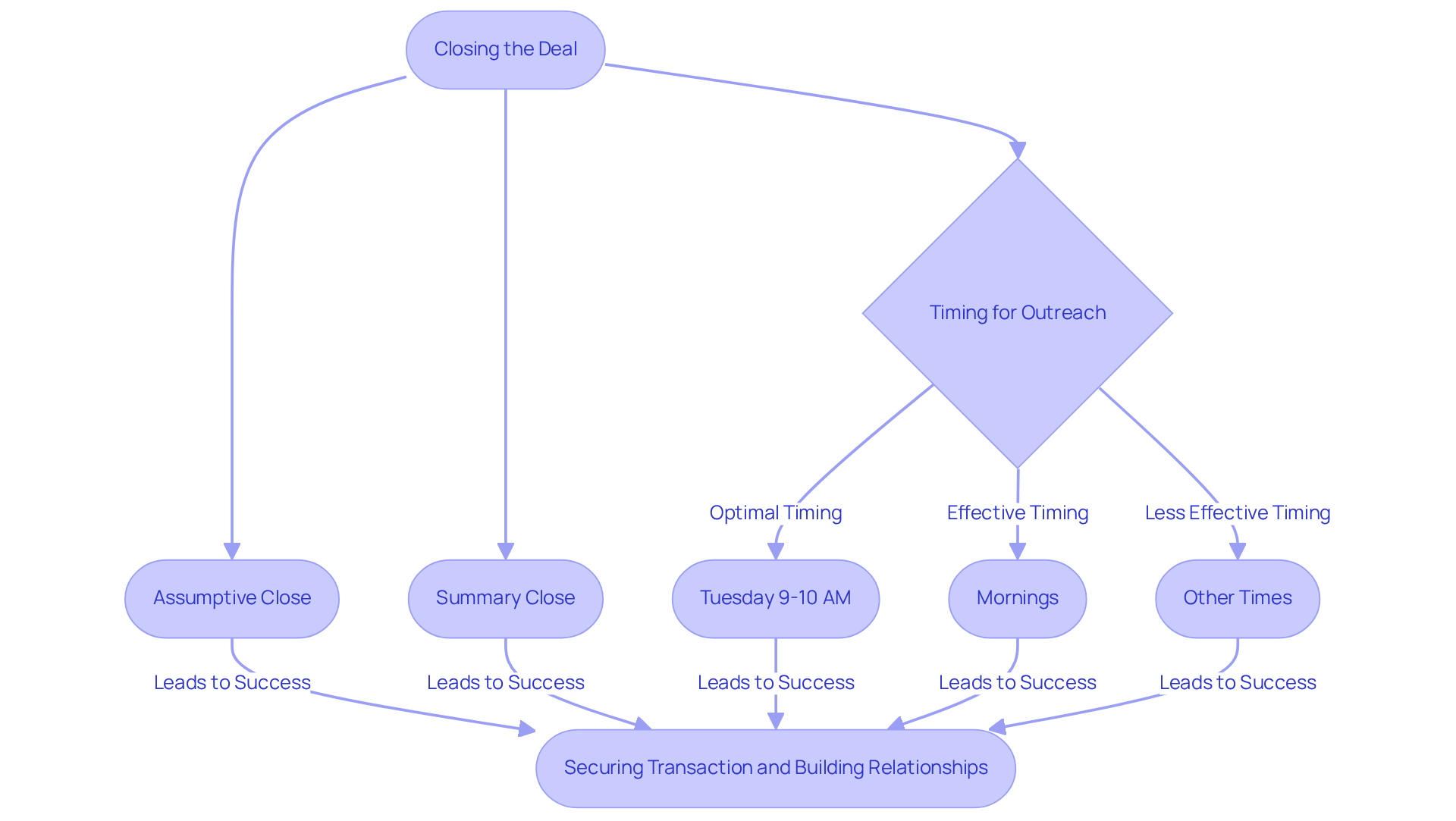
Renewal: Maintaining Relationships for Future Sales
Post-sale, nurturing a robust relationship with customers is essential for securing future renewals and maximizing upselling opportunities. Regular check-ins, personalized communication, and consistently delivering value are key strategies that keep customers engaged and satisfied. Notably, personalized emails boast a 29% open rate and a 41% click-through rate, underscoring the effectiveness of tailored communication in enhancing customer engagement.
By leveraging Websets, marketing teams can efficiently monitor customer interactions and preferences, enabling customized follow-up approaches that align with individual needs. This proactive relationship management not only enhances but also fosters loyalty, ultimately driving repeat business.
Research indicates that a mere 5% rise in customer retention can lead to a profit increase of 25-95%, highlighting the significant financial advantages of sustaining robust customer relationships.
As Chip Bell aptly states, "Loyal customers, they don’t just come back, they don’t simply recommend you, they insist that their friends do business with you.
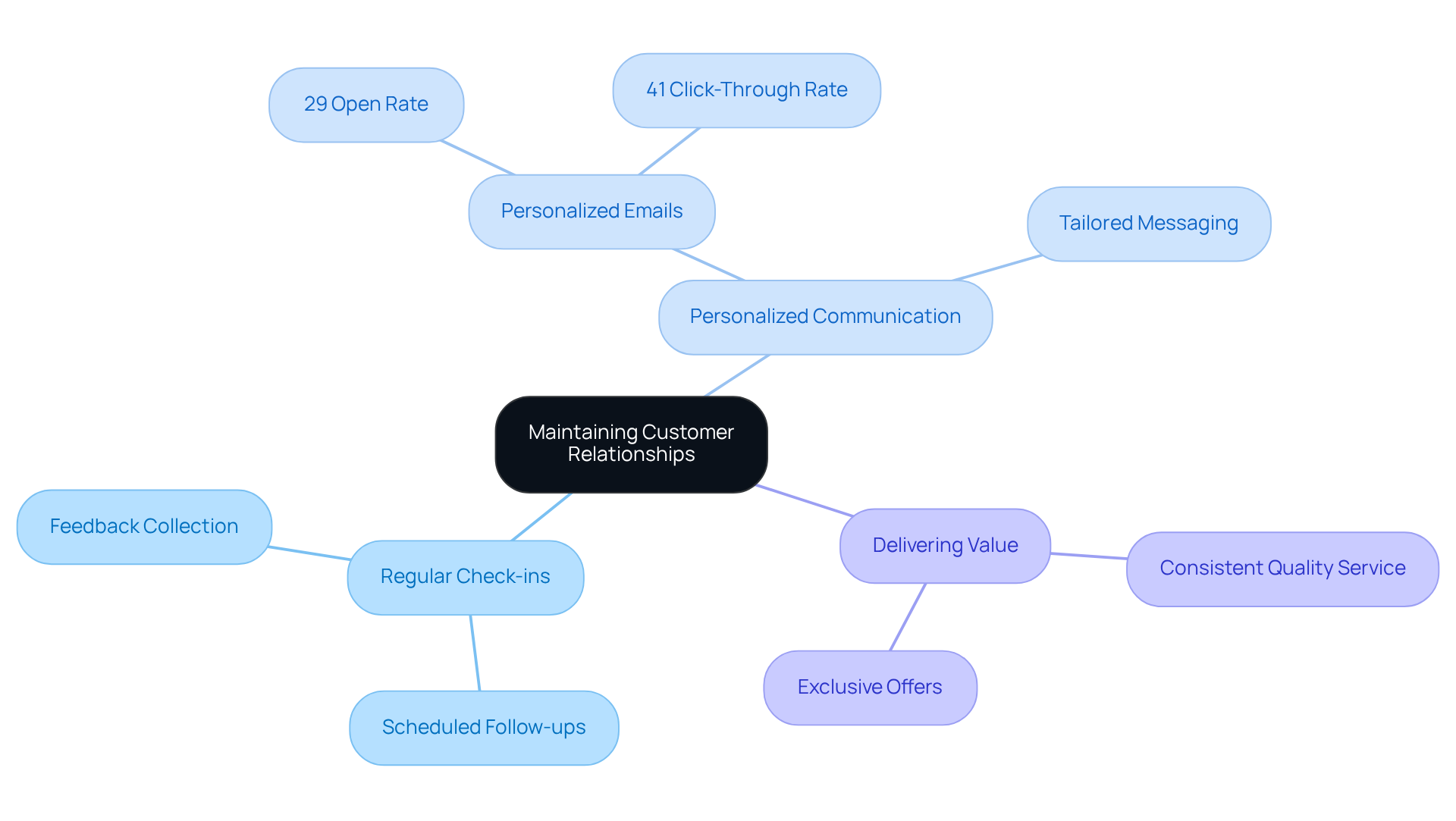
Sourcing vs. Sales Funnel: Key Differences Explained
While both sourcing and aim to transform prospects into clients, they serve distinct functions that require tailored approaches. The sourcing funnel is primarily focused on attracting and qualifying candidates for recruitment, ensuring that organizations efficiently identify the right talent. In contrast, the revenue funnel is designed to convert prospects into paying customers, highlighting the necessity of nurturing leads through various stages of engagement.
Recognizing these differences is crucial for businesses seeking to optimize their processes. Organizations that effectively differentiate their sourcing strategies from marketing tactics can significantly boost operational efficiency within the sourcing funnel and enhance conversion rates. Research shows that companies with well-defined funnels experience revenue growth that is 18 times greater than those without.
Moreover, understanding the nuances of each funnel allows for targeted optimization efforts. For instance, incorporating personalized calls to action (CTAs) can dramatically increase engagement, with personalized CTAs converting 202% better than generic ones. This strategic emphasis not only streamlines the recruitment process but also enhances the efficiency of marketing efforts, ultimately leading to improved outcomes across both domains.
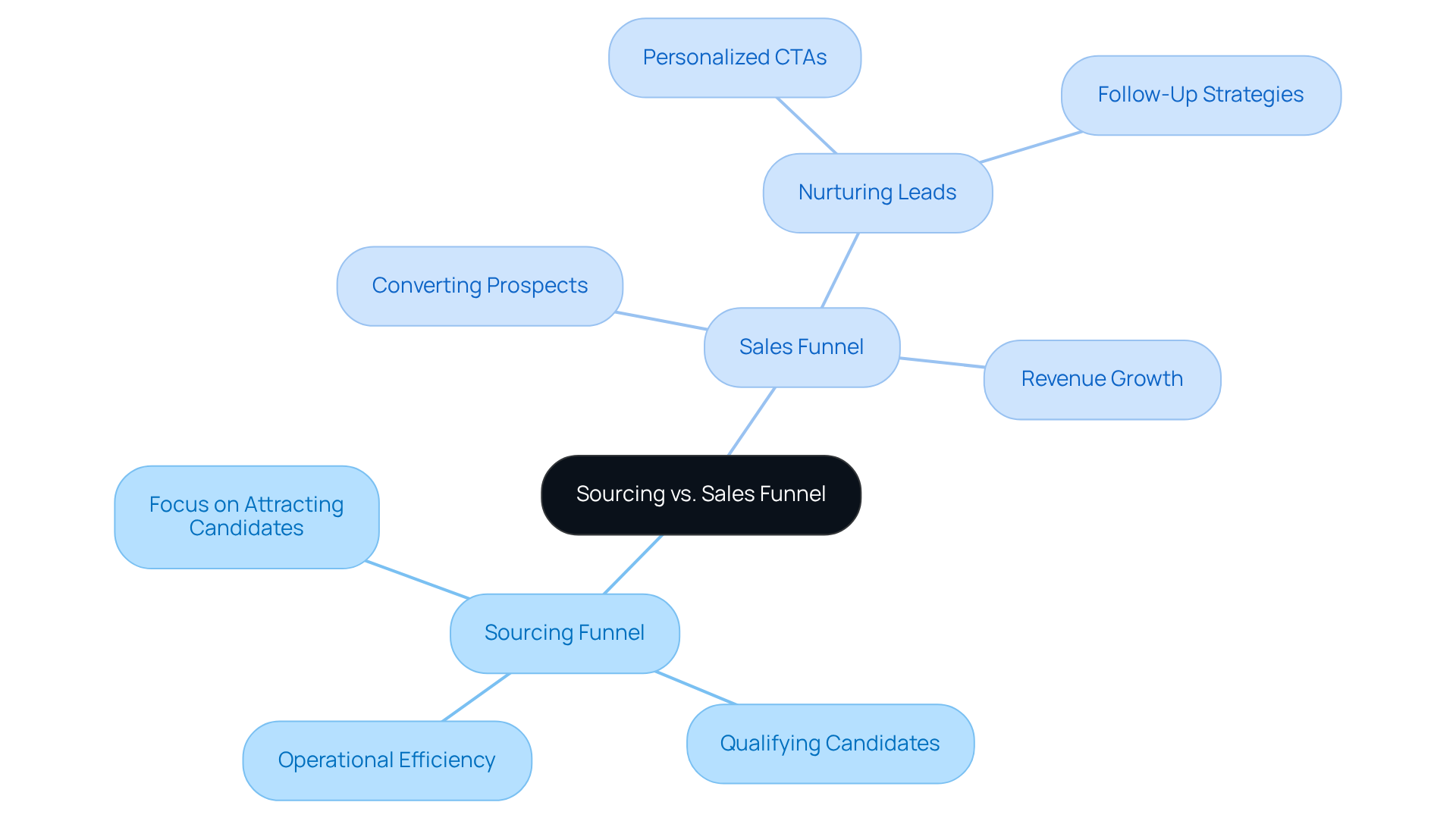
Full-Funnel Approach: Optimizing Sourcing Strategies
Adopting a sourcing funnel strategy empowers companies to deliver a seamless experience for prospects, guiding them from initial awareness to renewal. This approach hinges on the integration of marketing and sales efforts, ensuring consistent messaging and sustained engagement throughout the customer journey. By leveraging an AI-driven platform, organizations can refine their sourcing funnel strategies, effectively nurturing prospects at every stage. Sales teams can harness precise prospect generation capabilities to identify companies and individuals that meet hyper-specific criteria, enriching their outreach with valuable data, including emails and company details.
Furthermore, Websets provides AI-powered candidate discovery and market research tools, enabling organizations to filter candidates by skills and experience while analyzing market trends and competitor landscapes. This comprehensive methodology not only enhances conversion rates but also fosters lasting customer relationships. Organizations that align their marketing and sales departments can experience up to 24% faster revenue growth and 36% shorter cycles, underscoring the significant impact of coordinated efforts on client conversion.
Notable examples include organizations that have successfully integrated their marketing and business development functions, resulting in improved lead nurturing and overall performance. According to SiriusDecisions, 'B2B organizations with closely aligned commerce and marketing experience 24% quicker revenue growth and 27% faster profit growth over a 3-year period.' Moreover, firms with synchronized sales and marketing enjoy 38% higher win rates and 36% shorter cycles, illustrating the financial benefits of this alignment. To fully capitalize on these advantages, regularly to ensure they remain aligned and responsive to market dynamics.
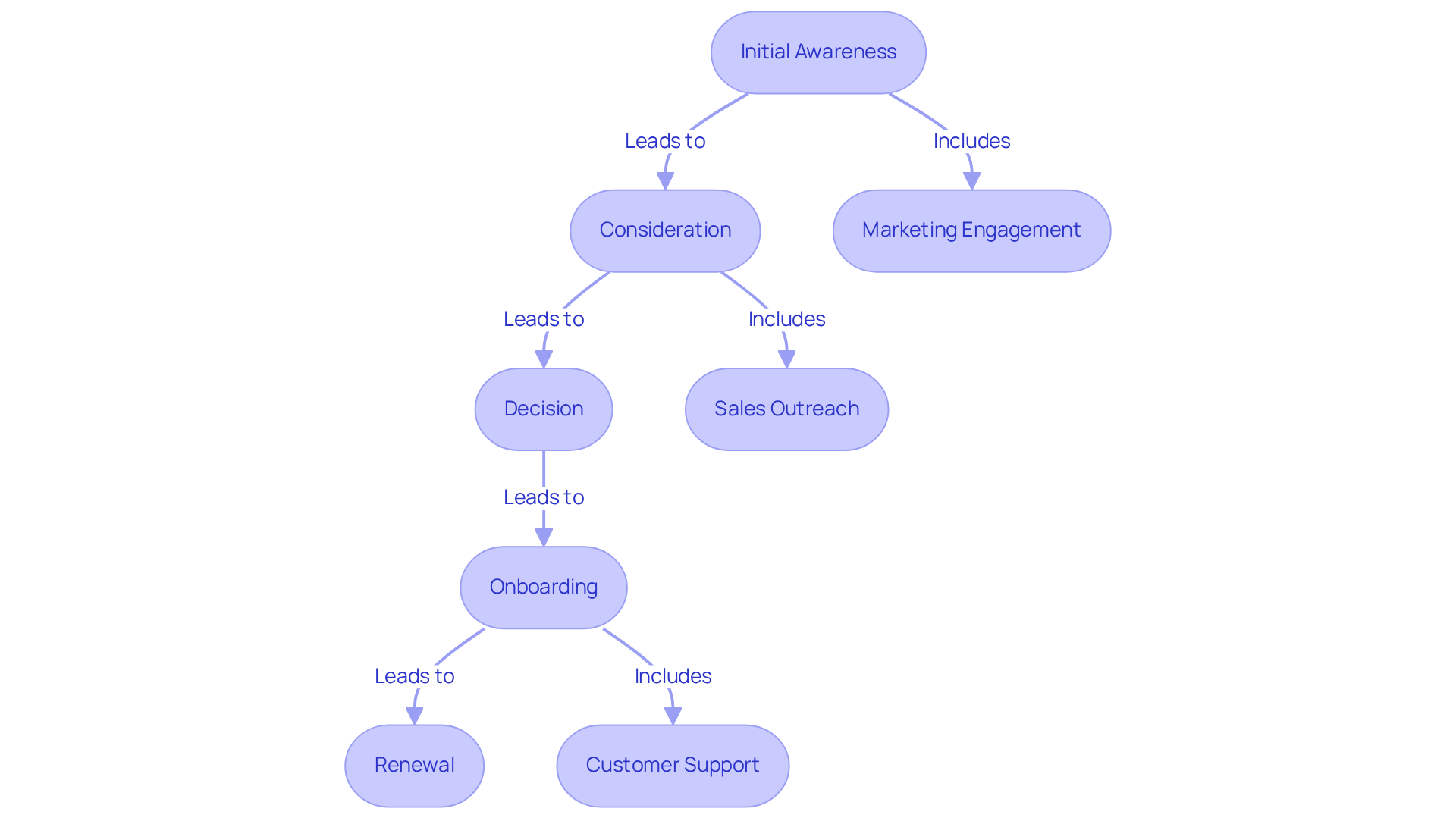
Measurement: Evaluating Success in the Sourcing Funnel
To maximize the effectiveness of sourcing strategies, businesses must establish comprehensive measurement frameworks. Key performance indicators (KPIs) such as conversion rates, prospect quality, and customer retention are essential metrics that should be monitored consistently. Tracking the reveals the percentage of leads that progress through the sourcing funnel. Additionally, lead quality assessments help identify the most promising prospects. Customer retention metrics provide insights into the effectiveness of post-sale engagement approaches.
The platform offers advanced analytics tools, including features from its OpenAPI Specification, allowing organizations to evaluate the performance of their sourcing funnel and identify areas for improvement. By leveraging Websets' AI-driven capabilities, companies can continuously measure these metrics, refine their sourcing strategies, and ultimately boost their lead generation efforts. This proactive approach drives sales success, ensuring that businesses remain competitive in a rapidly evolving market.
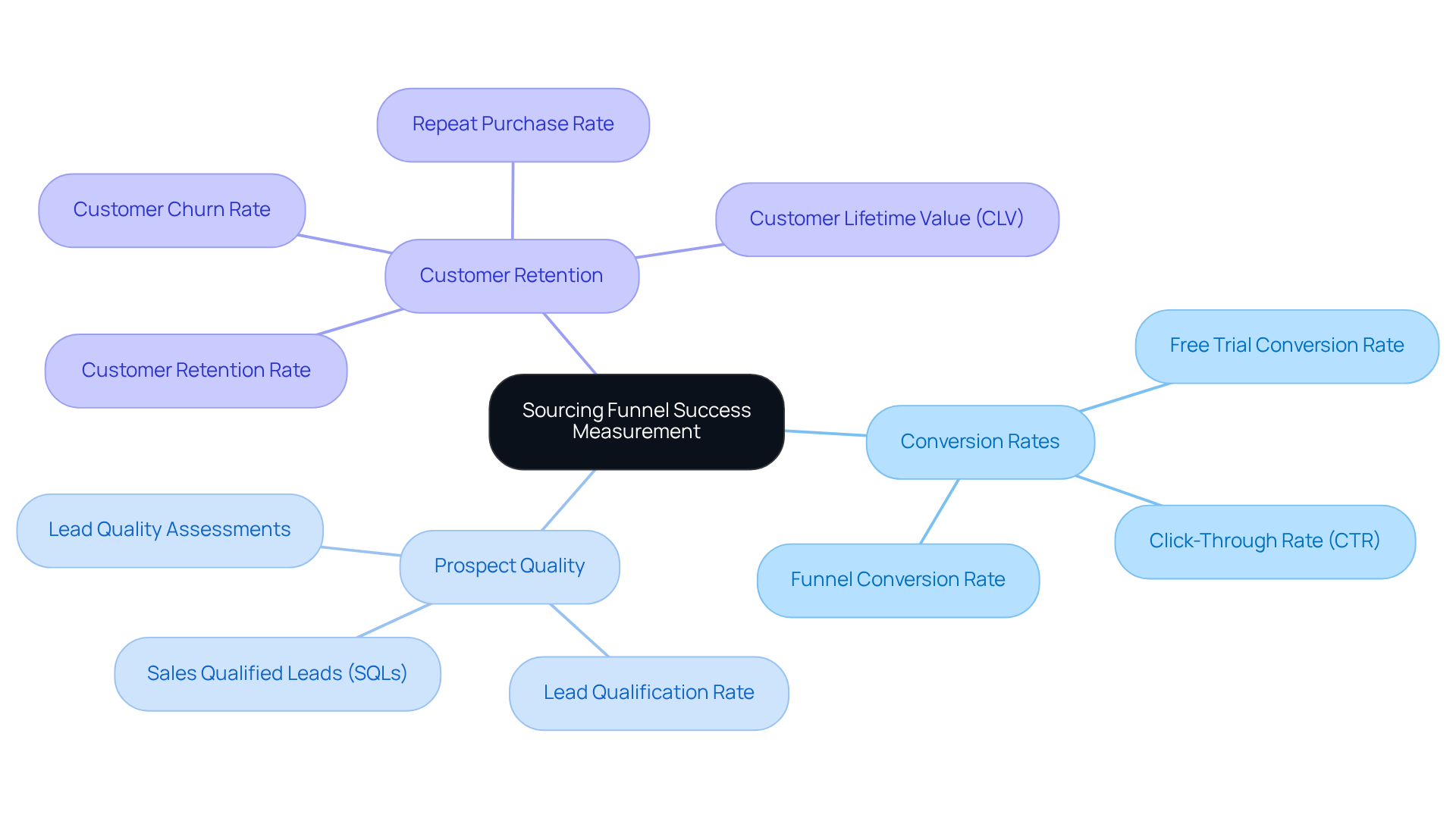
Conclusion
A structured approach to the sourcing funnel is essential for driving sales success. By understanding and implementing the key stages—from awareness to renewal—businesses can effectively navigate the complexities of lead generation and client engagement. The integration of AI technologies enhances this process, allowing for more precise targeting and improved operational efficiencies.
Several vital stages within the sourcing funnel are highlighted:
- Identifying potential leads through targeted strategies is crucial.
- Engaging them with personalized communication.
- Evaluating their fit based on specific criteria.
- The negotiation and closing phases are critical for finalizing agreements.
- The renewal stage ensures lasting relationships that can lead to future sales opportunities.
Each of these stages plays a significant role in optimizing the overall sales process.
The significance of the sourcing funnel cannot be overstated. Organizations that leverage AI-driven tools and adopt a full-funnel approach are poised to achieve remarkable improvements in conversion rates and customer retention. By continuously measuring key performance indicators, businesses can refine their strategies and remain competitive in an ever-evolving market landscape. Embracing these insights will not only enhance prospect engagement but also foster long-term success in sales.
Frequently Asked Questions
What is Websets and how does it assist in lead generation?
Websets is an AI-powered platform that revolutionizes B2B prospect generation by enabling businesses to quickly identify and engage with potential opportunities. Its advanced search engine navigates extensive datasets, providing essential information such as LinkedIn profiles, email addresses, and work histories, which enhances operational efficiency for sales teams and recruiters.
How does AI enhance client acquisition processes in lead generation?
AI enhances client acquisition through technologies like predictive analytics and natural language processing, which automate routine tasks and provide deeper insights into buyer behavior. This leads to more targeted outreach, resulting in improved conversion rates and reduced client qualification times.
What kind of results have organizations seen by using AI in their prospect generation strategies?
Organizations that have integrated AI into their prospect generation strategies have reported significant improvements, such as up to a 10% increase in conversion rates and a 30% reduction in sales timelines.
What strategies can businesses use to attract potential prospects in the awareness stage?
Businesses can attract potential prospects by leveraging AI-driven capabilities to identify prospects based on specific criteria like industry, job title, and location. Efficient promotional approaches such as content marketing and social media outreach can also amplify visibility and attract potential clients.
What methods can be used to engage leads effectively after they become aware of offerings?
Effective engagement methods include personalized email campaigns, informative webinars, and targeted content that addresses specific pain points of the prospects.
Why is personalized communication important in lead engagement?
Personalized communication is important because 80% of consumers are more likely to engage with brands that tailor their messages to individual preferences. Additionally, 71% of B2B marketers consider email engagement a key performance metric, highlighting the need to track these metrics to refine engagement strategies.
How does Websets support teams in monitoring prospect behavior and engagement?
Websets provides advanced AI-driven tools for monitoring metrics related to prospect behavior, allowing teams to gain insights that ensure their engagement efforts resonate with the audience. Additionally, it offers resources like live demos and user manuals for effective tool utilization.
What is the significance of building relationships with prospects in the sourcing funnel?
Building relationships with prospects is crucial as it sustains their interest and motivates them to progress further in the sourcing funnel. Nurturing emotional bonds can significantly influence buyers' decisions, making relationship-building an essential component of effective marketing strategies.




